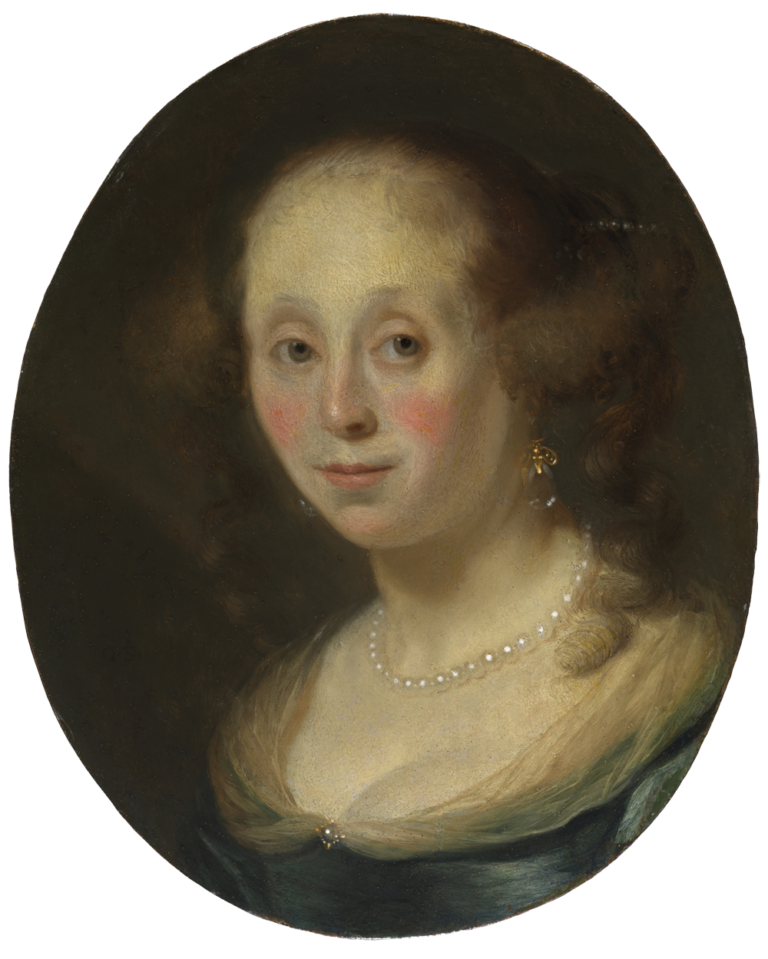The art of painting portrait miniatures in the Northern and Southern Netherlands has little to do with “the art of limning” as it was practiced in England and France. English miniatures, which were usually executed in gouache, watercolor or enamel, differ from those produced in the Low Countries in the sixteenth and seventeenth centuries. In Holland and Flanders, such portraits were commonly painted in oil on a support of wood or metal (usually copper). Moreover, unlike the English specialists in this field, the artists who painted portrait miniatures in the Netherlands never considered miniatures their main activity. They painted these tiny portraits alongside their regular work.
The production of miniature portraits in the Netherlands was certainly not a Leiden specialty.1 Nevertheless, it is striking that many Leiden artists—among them Gerrit Dou (1613–75); Frans van Mieris (1635–81), his sons Jan (1660–90) and Willem (1662–1747), and his grandson Frans II (1689–1763); Pieter van Slingelandt (1640–91); Ary de Vois (1630/35–80); Carel de Moor (1655–1738); and Godefridus Schalcken—produced signed work of this kind, not to mention the portrait miniatures attributable to Pieter Leermans (ca. 1670–85).2 That such small likenesses enjoyed a certain degree of popularity was due in part to their relatively modest price, but above all to their intimate nature: they were easy to carry around, and could even be worn on clothing. Schalcken’s Portrait of Maria Anna of Pfalz-Neuburg (1667–1740), Consort of Carlos II, King of Spain of 1690 is but one example.3
Despite its considerable popularity among Dutch artists and sitters in the seventeenth and eighteenth centuries, the portrait miniature is no longer held in such high esteem, certainly not in the art historical literature. Schalcken’s contribution to this specialty is definitely the least appreciated part of his oeuvre. Up to now, portrait miniatures by his hand have been discussed merely in entries in catalogues raisonnés of his work. Beherman’s book includes only nine, and not all of them are by Schalcken.4 Since Beherman’s publication, however, at least six more portrait miniatures signed by Schalcken have been found.5
One such recently discovered portrait is this exceptionally fine Portrait of a Woman, which the painter signed in monogram at the lower left. We see the young woman turning her head to her left as she looks at us with wide open eyes. She wears a blue-green dress with a low neckline, over which is draped a transparent ruche, held in place by a bejeweled broach. A string of pearls adorns her neck, but her most striking feature is her hairdo, a hurluberlu coiffure, in which the hair is drawn to the sides and falls in large ringlets over the shoulders. The rest of her hair is combed back and bound up in a large knot, or chignon, consisting of rolled-up braids. The chignon is held together by the string of pearls woven through it. The woman’s ears are decorated with pendant earrings made of gold wire and a large cut stone, probably a rock crystal. The light falls fully on her face and neck. The shadow at the left emphasizes the contours of the young lady’s pretty face and sets it off from the background.
The hurluberlu coiffure makes it fairly easy to date the tiny portrait, because this hairdo became fashionable in Paris only after 1670. Moreover, the signature—the monogram G.S.—indicates that the portrait could not have been painted very early in the 1670s. Until around 1675 Schalcken customarily signed even the smallest of his works in full. He did this on two miniatures with genre scenes, but more relevant in the present context is the full signature on the portrait miniature of Coenraet Ruysch (1650–1731) (fig 1), which Schalcken must have painted before Ruysch embarked on his Grand Tour in May 1674.6 The other portrait miniatures by his hand were all produced later and bear his monogram, which means that this Portrait of a Woman can be dated to between ca. 1675 and the early 1680s, before the hurluberlu coiffure went out of fashion and was succeeded by the high Fontange coiffure (see GS-106).
A recently discovered portrait miniature is Portrait of a Man in a White Wig.7 It is painted on copper, like the Portrait of a Woman, and is almost identical in size. Furthermore, it also bears Schalcken’s monogram. This male portrait can be dated to around 1680–85, so it is quite possible that these two portraits once formed a pair.
Incidentally, Schalcken’s activities in the field of miniature portraiture may well have prompted other painters in Dordrecht to attempt something similar. Schalcken’s pupil Arnoldus Boonen (1669–1729), at any rate, also painted portraits in miniature format, as did Barend Kalraet and Arnold Houbraken.
